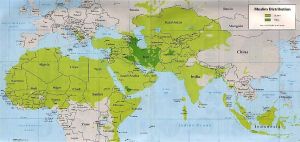Islamic World

Islamic world, often referred to as the Muslim world, encompasses a diverse range of cultures, languages, and histories united by the religion of Islam. Spanning from the Atlantic Ocean in the west to the Indonesian archipelago in the east, the Islamic world has played a significant role in shaping global civilization through its contributions to science, culture, and art. This article provides a comprehensive overview of the history, culture, and contributions of the Islamic world.
Historical Overview[edit | edit source]
The Rise of Islam[edit | edit source]
Islam, founded in the 7th century by the Prophet Muhammad in the Arabian Peninsula, quickly spread across the Middle East and beyond. After Muhammad's death in 632 AD, the Rashidun Caliphate was established, marking the beginning of a series of Islamic caliphates that would expand the Islamic world.
Umayyad and Abbasid Caliphates[edit | edit source]
- Umayyad Caliphate (661-750 AD): The Umayyad dynasty expanded the Islamic empire to its greatest territorial extent, stretching from Spain in the west to India in the east. This period saw the integration of diverse cultures and the establishment of Arabic as the administrative language.
- Abbasid Caliphate (750-1258 AD): The Abbasids took over from the Umayyads and shifted the capital to Baghdad. This era is often considered the Golden Age of Islam, characterized by significant advancements in science, medicine, philosophy, and the arts. Baghdad became a global center for learning and culture.
Later Islamic Empires[edit | edit source]
- Ottoman Empire (1299-1922 AD): The Ottoman Empire was one of the longest-lasting and most influential Islamic empires. At its height, it controlled much of Southeastern Europe, Western Asia, and North Africa. The Ottomans contributed significantly to art, architecture, and the spread of Islamic culture.
- Safavid Empire (1501-1736 AD): The Safavid dynasty established Twelver Shia Islam as the state religion of Persia (modern-day Iran) and promoted a rich cultural renaissance, particularly in the arts and architecture.
- Mughal Empire (1526-1857 AD): The Mughals ruled a vast empire in the Indian subcontinent, known for its architectural achievements such as the Taj Mahal, and for fostering a syncretic culture that blended Persian, Indian, and Islamic traditions.
Cultural Contributions[edit | edit source]
Science and Medicine[edit | edit source]
The Islamic Golden Age saw remarkable contributions to various fields of science and medicine. Scholars translated and preserved the works of ancient Greek, Indian, and Persian scientists, while also making original contributions.
- Algebra and Mathematics: Mathematicians like Al-Khwarizmi made significant advances in algebra, algorithms, and trigonometry.
- Astronomy: Islamic astronomers improved the astrolabe and developed accurate astronomical tables.
- Medicine: Figures like Avicenna (Ibn Sina) wrote comprehensive medical encyclopedias, such as "The Canon of Medicine," which were used as standard texts in Europe for centuries.
Art and Architecture[edit | edit source]
Islamic art and architecture are renowned for their intricate designs, geometric patterns, and calligraphy.
- Calligraphy: Arabic calligraphy, often used to transcribe the Quran, is a highly esteemed art form.
- Architecture: Notable architectural achievements include the Great Mosque of Cordoba, the Alhambra in Spain, and the Dome of the Rock in Jerusalem.
- Textiles and Ceramics: The Islamic world produced exquisite textiles and ceramics, known for their detailed craftsmanship and vibrant colors.
Literature and Philosophy[edit | edit source]
Islamic literature and philosophy have made enduring contributions to global thought and culture.
- Poetry: Poets like Rumi and Omar Khayyam have left a lasting legacy with their mystical and philosophical verses.
- Philosophy: Islamic philosophers like Al-Farabi, Al-Ghazali, and Averroes (Ibn Rushd) engaged deeply with Greek philosophy and made significant contributions to metaphysics, ethics, and political philosophy.
Modern Islamic World[edit | edit source]
Today, the Islamic world is diverse, with over 1.8 billion Muslims worldwide. Countries with significant Muslim populations span from Morocco in North Africa to Indonesia in Southeast Asia. The modern Islamic world continues to evolve, with ongoing contributions to global culture, politics, and economics.
Contemporary Challenges and Achievements[edit | edit source]
- Economic Development: Many Muslim-majority countries are experiencing rapid economic growth and development.
- Education and Science: Efforts are being made to revitalize the Islamic world's historical contributions to science and education, with investments in research and higher education.
- Cultural Renaissance: There is a renewed interest in preserving and promoting Islamic cultural heritage, including art, literature, and traditional practices.
Conclusion[edit | edit source]
The Islamic world has a rich and complex history marked by significant contributions to human civilization. From scientific advancements and architectural marvels to profound philosophical and literary works, the Islamic world continues to influence and shape global culture. Understanding the history and achievements of the Islamic world not only enriches our knowledge but also fosters a greater appreciation for its diverse and enduring legacy.